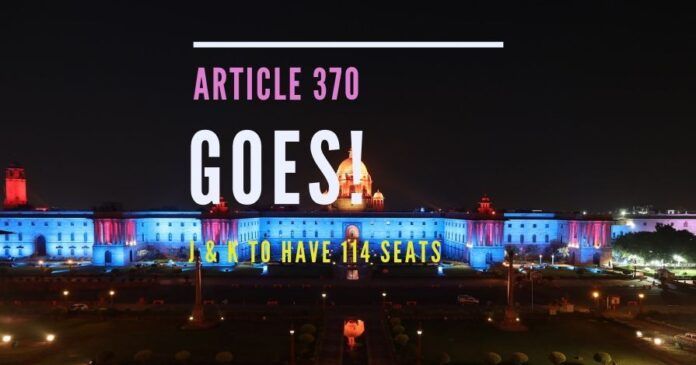
The new Union Territory Jammu & Kashmir will have a maximum number of 107 Assembly seats which will be further enhanced to 114. The Bill passed by the Rajya Sabha on Monday specified the starting of Delimitation process which is expected to increase the number of seats from Jammu region[1]. This will lead to the end of hegemony of the Kashmir region, which was enjoying supremacy of number of seats and getting an artificial victory for the past seven decades.
At present, the effective strength of the Jammu and Kashmir Assembly is 87, including four seats falling in the Ladakh region, which will now be a separate Union Territory (UT) without a legislature. Twenty-four seats of the Assembly continue to remain vacant as they fall under Pakistan-occupied Kashmir (PoK).
“…The number of seats in the Legislative Assembly of Union territory of Jammu and Kashmir shall be increased from 107 to 114, and delimitation of the constituencies may be determined by the Election Commission in the manner hereinafter provided,” according to the J & K Reorganisation Bill, 2019, introduced by Union Home Minister Amit Shah in Rajya Sabha on Monday. The total 58 page J & K Reorganisation Bill, 2019 is published below this article.
The UT of Ladakh will have Kargil and Leh districts. There shall be a council of ministers in the successor UT of J-K, the Bill said, consisting of not more than ten per cent of the total number of members in the Legislative Assembly, with the Chief Minister at the head “to aid and advise” the Lieutenant Governor in the exercise of his functions in relation to matters with respect to which the Legislative Assembly has the power to make laws.
The new Bill said that the new UT will have a reservation in the Assembly seats. “The number of seats to be reserved for the Scheduled Castes and the Scheduled Tribes in the Legislative Assembly, having regard to the relevant provisions of the Constitution…,” it said. The Bill said that the Lieutenant Governor of the successor UT of J-K may nominate two members to the Legislative Assembly to give representation to women, if in his opinion; women are “not adequately” represented in the Legislative Assembly.
It also said that the Lok Sabha will have five seats from the UT of J-K, while Ladakh will have one seat. This means that there is no change in the total number of seats. “On and from the appointed day, there shall be allocated five seats to the successor UT of J-K and one seat to UT of Ladakh, in the House of the People, and the First Schedule to the Representation of the People Act, 1950 (43 of 1950) shall be deemed to be amended accordingly,” it said.
The total 58 page J & K Reorganisation Bill, 2019 is published below:
Jammu and Kashmir Reorganisation Bill, 2019 by PGurus on Scribd
References:
[1] Delimitation debate – Jun 25, 2019, The Pioneer
- Supreme Court rejects plea to tally all VVPAT slips with EVM votes; says ‘no going back to paper ballot’ - April 26, 2024
- US report citing human rights violations is deeply biased: India - April 25, 2024
- Kotak Mahindra Bank shares tank 13%. Market Cap erodes by Rs.37,721 cr post-RBI action - April 25, 2024











[…] खबर को अंग्रेजी में यहाँ […]